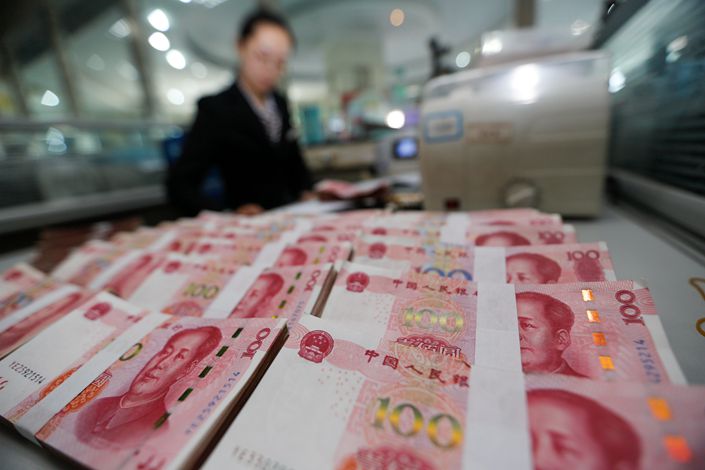Rural Bank’s Ratings Cut After Bad Loans Soar

A Chinese rural bank has had its credit ratings downgraded due to a surge in bad loans that wiped out its capital buffers, after the regulator ordered lenders to classify more of their overdue loans as soured assets.
The issuer rating of Guiyang Rural Commercial Bank (GRCB) was lowered by one notch to A+ from AA-, China Chengxin International Credit Rating Co. Ltd. said in a statement dated Friday. The agency also cut the ratings on two of the bank’s bonds to A from A+.
The downgrade “reflects the multiple challenges facing GRCB,” the statement said, pointing to problems including a “sharp” increase in non-performing loans (NPLs), a significant decline in profit and capital indicators, and the need for improvement in the bank’s risk management, the statement said. Chengxin also noted that the bank’s operations could be easily affected by changes in the local economy and financial environment.
GRCB is based in Guiyang, the capital of Guizhou province in Southwest China, one of the country’s poorest regions. It is owned by the Guiyang city government.
The bank’s deteriorating financial position has been brought about partly by changes in regulatory requirements for the recognition of bad debts, which have forced many lenders to reclassify loans at risk of non-payment.
Bad loans surge
Chengxin said in its statement that as a result of an order to speed up bad-debt recognition, GRCB classified most of the loans on its books that were overdue by 90 days or more as NPLs at the end of last year. As a result, its non-performing loans soared to 7.84 billion yuan ($1.18 billion) at the end of December from 840.7 million yuan at the end of 2015, causing its NPL ratio to jump to 19.54% from 2.93% over the same period, it said.
The China Banking and Insurance Regulatory Commission has given city and rural commercial banks until the end of 2019 to classify all loans more than 90 days overdue as NPLs, as the authorities step up efforts to make China’s lenders come clean about the extent of their bad debts, a source told Caixin earlier this month. But some local regulators are requiring lenders to comply even earlier.
The soaring bad loans forced GRCB to set aside an additional 5.18 billion yuan in reserves to cover losses on its lending. As a result, its capital adequacy ratio, a key metric indicating a bank's ability to absorb losses and meet its obligations, fell to less than 1% from 10.6% at the end of 2015.
Its core Tier-1 capital adequacy ratio turned negative, falling to -1.41% at the end of 2017 from 7.59% at the end of 2015. Core Tier 1 capital consists of equity, retained earnings and other reserves, according to the Basel III international banking regulations, comprising the highest-quality capital a bank has to absorb losses.
Most of GRCB’s NPLs were in sectors such as wholesale and retailing, manufacturing, and property, which are vulnerable to economic headwinds and therefore are “rather difficult to be repaid,” Chengxin said.
The quality of the bank’s credit assets deteriorated in recent years as the local economy lost steam, the steel industry was plagued by excess capacity and “bubbles” grew in the real estate market, putting increasing pressure on small and medium-sized firms, the ratings agency said. It also criticized the bank’s lax management of loan approvals.
Further downgrade
Chengxin did note that there has been some improvement in the bank’s bad-debt position. Its NPL ratio declined to 13.86% at the end of March. Loans overdue by 90 days or more fell to 18.33% of its total lending, down from 24.3% at the end of 2017.
The ratings company said it may downgrade the bank’s ratings again if it sees a sharp deceleration in the growth of the local economy or if there is a deterioration in the bank's financial situation such as a drop in asset quality and a serious shortage of capital.
On the other hand, the ratings could be raised if there is a significant improvement in three areas: corporate governance and risk management, brand value and core competitiveness, according to the statement.
Contact reporter Fran Wang (fangwang@caixin.com)

- 1PDD Fires Government Relations Staff After Fistfight With Regulators
- 2China Sets 2026 Economic Priorities With Demand Revival at the Core
- 3In Depth: China Bad-Debt Managers’ Bet on Bank Stocks Could Backfire
- 4Beijing Moves to Rein in Steel Exports With New Licensing Rule
- 5China Ramps Up Effort to Offload Vast Supply of Unsold Homes
- 1Power To The People: Pintec Serves A Booming Consumer Class
- 2Largest hotel group in Europe accepts UnionPay
- 3UnionPay mobile QuickPass debuts in Hong Kong
- 4UnionPay International launches premium catering privilege U Dining Collection
- 5UnionPay International’s U Plan has covered over 1600 stores overseas






